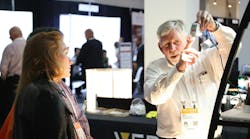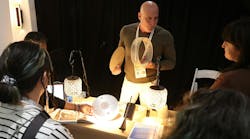An upgrade to main-road lighting in Sydney is expected to provide safety and asset-management improvements as well as energy savings via lighting controls. More than 62,000 light fixtures throughout the Sydney metropolitan area are being upgraded with energy-efficient LEDs and lighting controls to allow the service provider to quickly detect lighting faults and perform repairs.
The street lighting project, undertaken in stages by the Southern Sydney Regional Organization of Councils (SSROC) and its electricity distributor Ausgrid, has already resulted in more than 205,000 fixtures being converted to LEDs. Earlier phases of the project focused on residential roads and did not include smart controls.
LED lighting choices for each phase are influenced by intended use, noted Helen Sloan, the CEO of SSROC. “LED lighting on residential roads is generally being deployed at 3,000 Kelvin though other lower colour temperatures are available for environmentally sensitive areas,” she said. “LED lighting on main roads is being deployed at 4,000 Kelvin to maximise road safety outcomes. Most of the legacy lighting on main roads was high pressure sodium, so the transition to LEDs is whiter and brings much higher colour rendition to streetscapes. To minimise sky glow, obtrusive light and glare, all the new LED lights need to meet the latest versions of Australian standards.”
The lighting refit will eliminate mercury in the region’s public lighting, and all the old lamps will be recycled safely, Sloan noted. Australian lighting standards help ensure obtrusive light spill is reduced.
“Beyond the important transition to LEDs and smart controls, the main road lights also incorporate an additional port called a Zhaga receptacle. This 24V DC receptacle is downward facing and will allow a variety of smart city sensors to be plugged into the street lights in the future,” Sloan said.
The LED luminaires are certified to the Zhaga Book 18 global lighting standard. “Street lights are an ideal location for many smart city sensing tasks because they are ubiquitous, powered and elevated over the road reserve. Smart city sensors can measure parameters like traffic volumes, pollutants, climate parameters and noise levels. Using industry standard Zhaga receptacles may also make the street light the lowest cost location for widespread sensor deployment,” Sloan said.
The lighting controls installed as part of the current phase will provide key benefits. The lighting control network also will allow Ausgrid, the street lighting service provider, to optimize energy savings by dimming the roadway lights during off-peak periods, Sloan noted. The controls enable constant light output control, which maximizes luminaire life.
Ausgrid will use the lighting control network to pinpoint maintenance requirements. “Knowing the location of all the lights via a GPS chip, what type of lights they are (via data that is pre-programmed into the power supply), how much energy they are using (via a metering chip in the smart controls) and when faults occur, bring a wide range of maintenance efficiency and asset management benefits,” Sloan said.
The councils also plan to add sensors to monitor roadway traffic and pedestrian counts, ambient conditions, and pollutant and noise levels.
“The Ausgrid SSROC project is one of the largest smart lighting deployments of its kind in the world. Adopting a Zhaga-based approach is turning every street lighting into a platform for low-cost smart city sensor deployment. Enhancing the capabilities of street lighting to support sensors ensures that this deployment will be truly future proof,” Heinrich Thye, secretary general of the international Zhaga Consortium, said of the SSROC Ausgrid initiative in a release.
When the latest phase is complete, more than 240,000 streetlights will have been refitted with LEDs and, where appropriate, lighting controls. Energy consumption will be cut by more than 60%, or a reduction 78,000 MWh each year, Sloan said. In addition, a separate SSROC program ensures that most councils have 100% renewable energy supply.
Implementing off-peak dimming could further increase energy savings. “Councils are already achieving savings of more than $10 million per year from the 205,000 LEDs deployed to date. The additional $3 million in savings from the latest phase of main road LEDs is expected to take total savings to more than $13 million per year,” Sloan noted.






